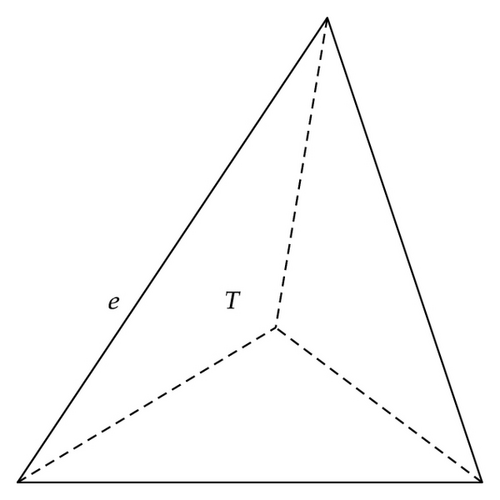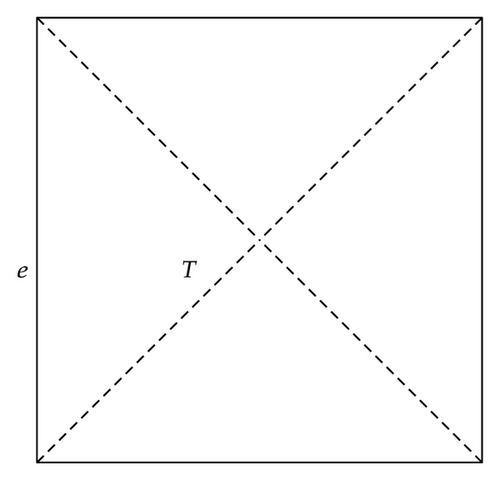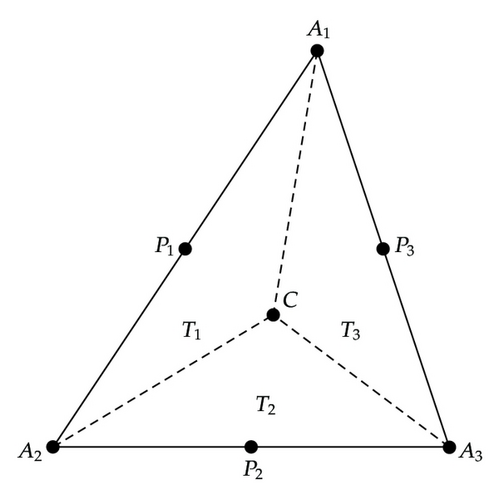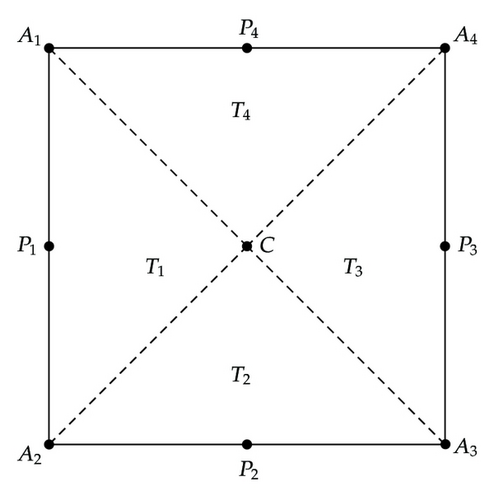A Discontinuous Finite Volume Method for the Darcy-Stokes Equations
Abstract
This paper proposes a discontinuous finite volume method for the Darcy-Stokes equations. An optimal error estimate for the approximation of velocity is obtained in a mesh-dependent norm. First-order L2-error estimates are derived for the approximations of both velocity and pressure. Some numerical examples verifying the theoretical predictions are presented.
1. Introduction
The study of discontinuous Galerkin methods has been a very active research field since they were proposed by Reed and Hill [1] in 1973. Discontinuous Galerkin methods use discontinuous functions as finite element approximation and enforce the connections of the approximate solutions between elements by adding some penalty terms. The flexibility of discontinuous functions gives discontinuous Galerkin methods many advantages, such as high parallelizability and localizability. Arnold et al. [2] provided a framework for the analysis of a large class of discontinuous Galerkin methods for second-order elliptic problems.
Based on the advantages of using discontinuous functions for approximation in discontinuous Galerkin methods, it is natural to consider using discontinuous functions as trial functions in the finite volume method, which is called the discontinuous finite volume method. Such a method has the flexibility of the discontinuous Galerkin method and the simplicity and conservative properties of the finite volume method. Ye [3] developed a new discontinuous finite volume method and analyzed it for the second-order elliptic problem. Bi and Geng [4] proposed the semidiscrete and the backward Euler fully discrete discontinuous finite volume element methods for the second-order parabolic problems. Ye [5] considered the discontinuous finite volume method for solving the Stokes problems on both triangular and rectangular meshes and derived an optimal order error estimate for the approximation of velocity in a mesh-dependent norm and first-order L2-error estimates for the approximations of both velocity and pressure.
The Darcy-Stokes problem is interesting for a variety of reasons. Apart from being a modeling tool in its own right, it also appears, less obviously, in time-stepping methods for Stokes and for high Reynolds number flows (where of course the convective term causes additional difficulties). In [6], the nonconforming Crouzeix-Raviart element is stabilized for the Darcy-Stokes problem with terms motivated by a discontinuous Galerkin approach. In [7], a new stabilized mixed finite element method is presented for the Darcy-Stokes equations.
In this paper, we will extend the discontinuous finite volume methods to solve the Darcy-Stokes equations. In our methods, velocity is approximated by discontinuous piecewise linear functions on triangular meshes and by discontinuous piecewise rotated bilinear functions on rectangular meshes. Piecewise constant functions are used as the test functions for velocity in the discontinuous finite volume methods. We obtained an optimal error estimate for the approximation of velocity in a mesh-dependent norm. First-order L2-error estimates are derived for the approximations of both velocity and pressure. For the sake of simplicity and easy presentation of the main ideas of our method, we restrict ourselves to the model problem.
2. Discontinuous Finite Volume Formulation
Let ℛh be a triangular or rectangular partition of Ω. The triangles or rectangles in ℛh are divided into three or four subtriangles by connecting the barycenter of the triangle or the center of the rectangles to their corner nodes, respectively. Then we define the dual partition 𝒯h of the primal partition ℛh to be the union of the triangles shown in Figures 1 and 2 for both triangular and rectangular meshes.




Lemma 2.1. There exists a positive constant C independent of h such that
Proof. As in [4],
Lemma 2.2 (see [4].)The operator γ is self-adjoint with respect to the L2-inner product, (u, γv) = (v, γu), ∀ u, v ∈ Vh. Define ∥|v∥|0 = (v, γv) 1/2. Then ∥|·∥|0 and ∥·∥ are equivalent; here the equivalence constants are independent of h. And ∥γv∥ = ∥v∥, ∀ v ∈ Vh.
Let ∇hv and ∇h · v be the functions whose restriction to each element ∀K ∈ ℛh is equal to ∇v and ∇·v, respectively.
Lemma 2.3. For v, w ∈ V(h), there exists a positive constant C independent of h such that
Lemma 2.4 (see [5].)For any (v, q) ∈ V(h) × Qh, one has
Lemma 2.5 (see [5].)For , there exists a positive constant M independent of h such that
Lemma 2.6. For any v ∈ Vh, there is a constant C0 independent of h such that for α large enough
Proof. Using the proof of Lemmas 3.1 and 3.5 in [5], for v ∈ Vh,
3. Error Estimates
We will derive optimal error estimates for velocity in the norm ∥|·∥| and for pressure in the L2-norm. A first-order error estimate for velocity in L2-norm will be obtained.
Lemma 3.1. The bilinear form B(·, ·) satisfies the discrete inf-sup condition
Proof. For and q ∈ Qh, we have B(v, q) = (∇h · v, q), and ∥|v∥|1 = ∥v∥1,h. By Poincare-Friedrichs ∥v∥1,h ≤ C | v|1,h, with (3.3), and (2.17) we get for any q ∈ Qh
Theorem 3.2. Let (uh, ph) ∈ Vh × Qh be the solution of (2.27), and let ) be the solution of (1.1a)–(1.1c). Then there exists a constant C independent of h such that
Proof. Let ε = u − Π1u, εh = uh − Π1u, η = p − Π2p, ηh = ph − Π2p, where Π2 is L2 projection from . Then u − uh = ε − εh, p − ph = η − ηh. Subtracting (2.26) from (2.27) and using Lemma 2.4, we get error equations
Discrete inf-sup condition (3.4), (3.15a), (3.15b), Lemmas 2.5, 2.4, and inverse inequality give
Using Lemma 2.1, (3.12), and (3.13), we have
4. Numerical Experiments
In this section, we present a numerical example for solving the problems (1.1a)–(1.1c) by using the discontinuous finite volume element method presented with (2.27) and (2.42). Let Ω = (0,1)×(0,1), ℛh be the Delaunay triangulation generated by EasyMesh [10] over Ω with mesh size h as shown in Figure 5. We consider the case of σ = 1, μ = 1, the exact velocity u1(x, y) = −x2(x − 1) 2y(y − 1)(2y − 1), u2(x, y) = −u1(y, x) and the pressure p(x, y) = (x − 0.5)(y − 0.5). Denote the numerical solution as uh and ph with step hd which is used to generate the mesh data in the EasyMesh input file, and h = max {he : e ∈ Γ}. For α = 2, the numerical results are presented in Tables 1 and 2. It is observed from the tables that the numerical results support our theory.
| hd | h | |∥u − uh∥| | ∥u − uh∥ | ∥p − ph∥ | |||
|---|---|---|---|---|---|---|---|
| 1/8 | 1.598e − 1 | 2.082e − 2 | 3.393e − 4 | 1.068e − 2 | |||
| 1/16 | 8.372e − 2 | 1.031e − 2 | 2.0 | 9.649e − 5 | 3.5 | 5.345e − 3 | 2.0 |
| 1/32 | 3.679e − 2 | 5.185e − 3 | 2.0 | 2.598e − 5 | 3.7 | 2.650e − 3 | 2.0 |
| 1/64 | 1.899e − 2 | 2.611e − 3 | 2.0 | 6.795e − 6 | 3.8 | 1.323e − 3 | 2.0 |
| 1/128 | 9.413e − 3 | 1.307e − 3 | 2.0 | 1.730e − 6 | 3.9 | 6.598e − 4 | 2.0 |
| hd | h | |∥u − uh∥| | ∥u − uh∥ | ∥p − ph∥ | |||
|---|---|---|---|---|---|---|---|
| 1/8 | 1.598e − 1 | 2.071e − 2 | 3.280e − 4 | 1.079e − 2 | |||
| 1/16 | 8.372e − 2 | 1.027e − 2 | 2.0 | 9.204e − 5 | 3.5 | 5.380e − 3 | 2.0 |
| 1/32 | 3.679e − 2 | 5.175e − 3 | 2.0 | 2.476e − 5 | 3.7 | 2.659e − 3 | 2.0 |
| 1/64 | 1.899e − 2 | 2.608e − 3 | 2.0 | 6.361e − 6 | 3.8 | 1.325e − 3 | 2.0 |
| 1/128 | 9.413e − 3 | 1.306e − 3 | 2.0 | 1.613e − 6 | 3.9 | 6.603e − 4 | 2.0 |

Acknowledgments
This paper is supported by the Excellent Young and Middle-Aged Scientists Research Fund of Shandong Province (2008BS09026), National Natural Science Foundation of China (11171193), and National Natural Science Foundation of Shandong Province (ZR2011AM016).




